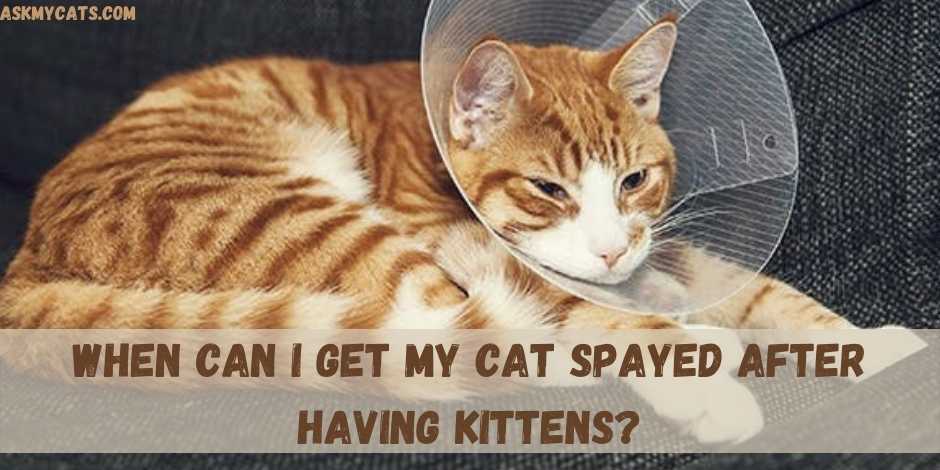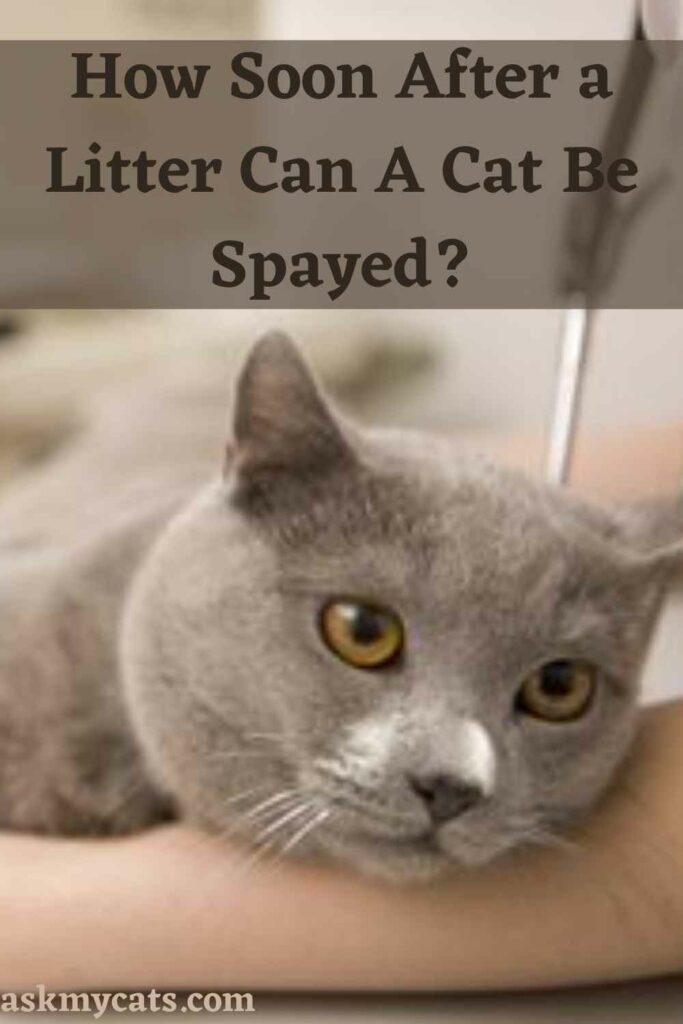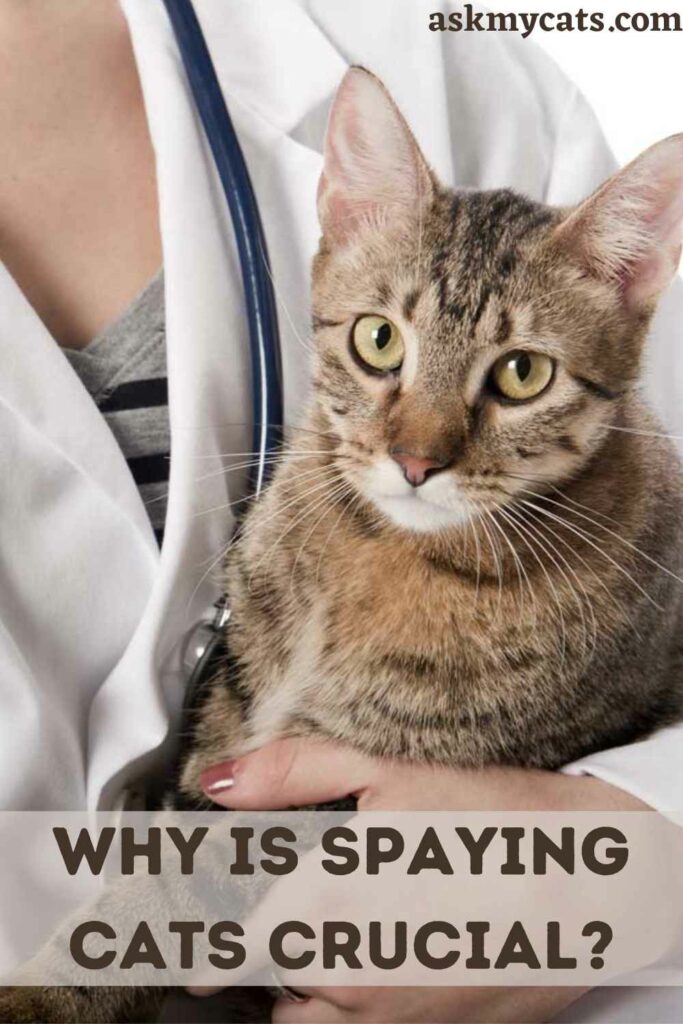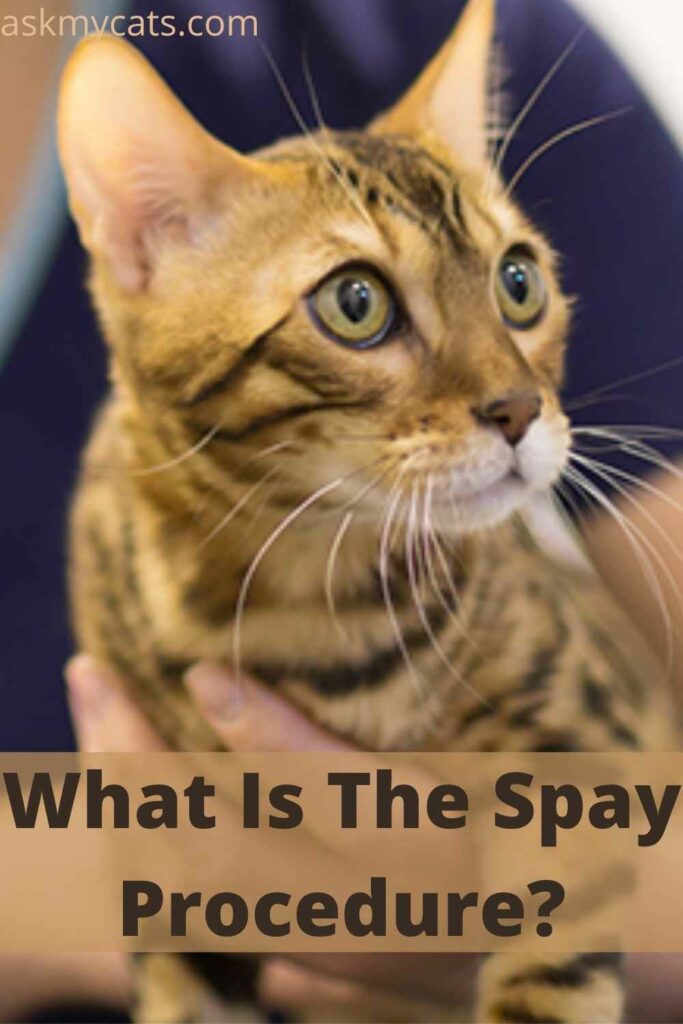Veterinarians frequently perform surgical procedures such as spaying and neutering. These procedures keep cats from having litters of kittens. A female animal’s ovaries, fallopian tubes, and uterus are removed during spay surgery.
However, if you have a cat that just gave birth to kittens, you might wonder when you can get your cat spayed.
You can get your female cat spayed five and six weeks after delivering her kittens when the kittens are nearly weaned. Allow her no contact with tomcats during this time because she may become pregnant again.
This article will talk all about when to spay your cat and its benefits.


Give Your Cat the Perfect Day
Get the Free Ebook!
How Soon After a Litter Can A Cat Be Spayed?
A cat can be spayed after five to six weeks after birthing a litter of kittens.

It’s safe to say you’ll be surprised when you take the cat in for a spay only to find out your vet can’t do it because she’s pregnant.
The procedure that would have prevented her pregnancy will have to be postponed.
After her litter is born, you won’t be able to get her spayed right away. She’ll be ready a few weeks after giving birth.
Your cat will be nursing her tiny furballs around the clock for weeks after giving birth to them.
You should not have her spayed during this time period because the surgery may be more complicated.
During the nursing stage, the mama kitty’s mammary glands swell due to milk production, making surgery unappealing to most veterinarians.
Wait until the kittens begin to wean before having your cat spayed.
According to the ASPCA, you should be able to start weaning your fluffy friends around 4 weeks of age. You can separate the kittens from their mother for a few hours at a time during this time.
Feed them gruel, kitten food that has been heavily soaked in water, or kitten milk replacer for four to six weeks, or until they are no longer nursing.
This weaning stage is the soonest you should spay your cat after she gives birth.
She can still produce milk for her babies when they require it, but they will be content to be separated from her for extended periods of time as they learn to eat and care for themselves.
If you have a non-neutered male cat in the house or if your queen is allowed to roam outside and mate with the neighborhood tomcat, spaying the cat soon after birth is critical.
She becomes fertile again shortly after her kittens are born – weeks before she begins weaning. You must keep her separate from intact male kitties for about a month before you can spay her.
Otherwise, you might have another litter of kittens a few months later.
It’s important to know how soon can a cat get pregnant after having kittens
Can A Pregnant Cat Be Spayed?
Yes, a pregnant cat can be spayed.
Spaying a pregnant cat is possible at any point throughout the pregnancy. The owner is frequently unaware that the cat is pregnant.
Tell your veterinarian what you want to happen if your cat becomes pregnant if you have any doubts. The incision can be closed to continue the pregnancy, or the spay can be performed, and the developing kittens, along with the rest of the uterus, will be removed.
Most vets will charge an additional cost for spaying a pregnant animal due to the extra effort and operation time. After a particular stage of pregnancy, some veterinarians will not knowingly spay a pregnant animal.
Experts are frequently questioned about what to deal with freshly adopted stray cats who are suspected of being pregnant.
Many people who work with a variety of rescue organizations are acutely aware of the pet overpopulation problem. Regardless of pregnancy, experts recommend spaying stray or recently adopted female cats.
There are already far too many kittens without homes.
Find out more details: Can You Spay a Pregnant Cat? Is It Safe?
Reasons To Spay Cats
There are reasons why you should spay your cat is that it provides several medical and behavioral benefits.
Medical Benefits
- Your female cat will live a healthier and longer life. Spaying aids in the prevention of uterine infections and breast tumors, which are malignant or cancerous in approximately 90% of cats. The best protection against these diseases is to spay your pet before her first heat.
- Neutering your male companion reduces the risk of testicular cancer and some prostate issues.
Behavioral Benefits
- Your spayed female pet will not become pregnant. Female felines typically go into heat four to five days every three weeks during the breeding season, though cycles vary. They’ll yowl and urinate more frequently, sometimes all over the house, in an effort to attract mates.
- Your male cats will be less likely to leave the house. An intact male will do almost anything to find a mate, including devising novel ways to get out of the house. He risks injury in traffic and fights with other male animals once he is free to roam.
- Your neutered and spayed cat may be more well-behaved. Unneutered cats are more likely to spray strong-smelling urine all over the house to mark their territory. After being neutered, your cat may be less likely to mount other cats, people, or inanimate objects. Early neutering may help to avoid some aggression issues.
- It is also very cost-effective to spay/neuter your pets. The cost of spaying or neutering your pet is far less than the cost of having and caring for a litter.
You might also like to know can a spayed cat get pregnant
Why Is Spaying Cats Crucial?
Spaying cats is crucial to keeping your cat healthy and reducing the population of kittens. According to AmericanHumane.org, approximately 3.7 million cats are put down at shelters each year due to a lack of willing and able adopters.

Spaying a cat refers to an ovariohysterectomy, which is the removal of parts of a female cat’s reproductive system to prevent her from becoming pregnant and giving birth to kittens.
Cat spaying is a surgical procedure that can only be performed correctly and safely by a veterinary surgeon.
Spaying a cat is a routine surgical procedure that carries a low risk of serious medical complications.
Unless your cat is purebred, there is no reason to continue allowing her to have kittens.
The reality is that, despite efforts to educate the public about the importance of spaying and neutering pets, there is still a significant pet overpopulation problem in the United States.
Because kittens are so popular, most people will end up adopting kittens rather than adult cats.
This leaves the adult cats without homes and at risk of being put down. The greater the number of kittens available, the greater the risk of putting them down for adult cats.
It’s best to have a female cat spayed after she’s had kittens and weaned them. By the age of four months, all kittens should be neutered or spayed.
When kittens reach sexual maturity, they can and will mate with their littermates. It’s best if they’re sterilized well ahead of time. Young cats becoming pregnant can be extremely dangerous.
According to AmericanHumane.org, shelters put down around 3.7 million animals each year owing to a shortage of willing and able adopters.
Spaying and neutering your cat ensures that you don’t contribute to this statistic and that none of your cat’s children become a fatal statistic.
Consider this: according to the Feral Cat Project, a non-spayed female cat can produce up to 100 more cats in her lifetime, including the litters of kittens her un-spayed kittens will later have. This astonishing figure, however, may be avoided simply by spaying or neutering your cat.
Your cats will be happier and make better pets as a result of spaying or neutering.
You might be surprised to know how many times can a cat get pregnant in a year
What Is The Spay Procedure?
The spay procedure refers to the ovariohysterectomy, or the removal of portions of the reproductive system of a female cat so she cannot get pregnant and give birth to kittens.

Spaying a cat is a surgical treatment that only a veterinary specialist can execute correctly and safely.
Spaying a cat is a relatively simple surgical treatment with a low risk of major medical problems.
The following procedures are used to spay a cat:
- Analgesic (pain) and anti-anxiety (calming) drugs with several modes of action is given.
- To keep the cat comfortable throughout the treatment, your veterinarian will use a general anesthetic.
- The attending veterinary team checks your cat’s breathing and heart rate, oxygen levels, blood pressure, and overall health during the anesthetic operation.
- A minor incision removes the ovaries, fallopian tubes, and uterus in your cat’s abdomen.
- Your veterinarian uses sutures to close the wound.
- Your veterinarian may also offer you post-operative instructions. Although spaying a cat may cause some discomfort immediately following surgery, your veterinarian will prescribe several pain-relieving treatments.
If you’re unsure whether or not to spay your cat, consult your veterinarian at your next appointment for assistance in making an informed and responsible decision.
Must Read: Can A Spayed Cat Nurse Kittens?
What Are The Complications Of Spaying A Cat
The Complications with spaying a cat are: –
- There is always a potential that your cat will experience negative side effects after being spayed, just as there is with any form of invasive surgery. Some animals react badly to the anesthesia used in surgery, and significant problems, including death, can result.
- Infections might also develop at the surgical site. Infections will be treated with antibiotics, and keeping the operation site clean can help reduce infection risk.
- If your cat eats her sutures, a no-chew cone may be placed around her neck to prevent her from accessing the operation site until it heals completely.
Will Cat’s Personality Change After Spaying?
Yes, a cat’s personality will change after spaying, but it will ultimately be for the better.
Your cat’s personality will alter as a result of spaying or neutering, but it will be for the better. Hormones control the behavior of unfixed cats.
Female cats in heat are agitated, anxious, and vocal, and they attract unneutered males in the area. Unneutered males are also more likely to become frustrated and aggressive, and territorial by spraying around the house.
They’ll almost certainly fight any man they come across. Exercise and a healthy diet are also essential for a smooth transition.
However, there is no requirement for them to gain weight. Indoor cats can eat a variety of foods designed specifically for them.
A laser pointer can be used to give them a nice workout for exercise. When you spay your cat, it becomes more relaxed and quiet, is less prone to wander away from home, and is a better pet overall.
You might like to read Do Cats Get Nicer After Being Spayed? Has Spay Affected My Cat’s Behavior?
Or you can also check out Cat Acting Hyper After Neuter? Know All The Possible Reasons!
Frequently Asked Questions
What are the health benefits of spaying a cat?
Ans. Spaying your cat also has a number of health benefits. Female cats who have been spayed are roughly 40% to 60% less likely to develop mammary cancer than cats who have not been spayed. Spaying also removes the risk of developing tumors in the reproductive system as well as the risk of infection in the reproductive tract. Feline leukemia (FeLV) and feline AIDS are more common in cats who mate or fight (FIV). Sadly, these diseases are only found in cats and are incurable. Your cat’s risk of developing either of these diseases is greatly reduced when they are spayed.
What should be done before the spaying surgery?
Ans. Your veterinarian will examine your cat before the surgery to ensure she is healthy enough to be operated on. Cats as young as 8 weeks old can be spayed to lessen the possibility of unintended pregnancy. (spaying on time has a health benefit as well.) Spaying older animals is possible if your veterinarian believes that they are healthy enough to undergo the procedure. Spaying a cat that is in heat is generally not a smart choice since it increases the risk of blood loss.
Should I allow my female cat to have one litter before spaying her?
Ans. No. There is no medical evidence that it is beneficial. Spaying a female cat before her first heat cycle can reduce her risk of breast cancer and provide other health and behavioral benefits.
Final Words
So, you must wait for 5 to 6 weeks before getting your female cat spayed after she has given birth. You must keep her away from other male cats and restrict her from going outside as she can become pregnant again.
After the waiting period is over, and the kittens as weaned, you should consult your vet and spay your cat as soon as possible, to keep it healthy and reduce the risk of several diseases.
If you have any questions, feel free to ask us in the comments section.
Also, check out When Can My Cat Go Outside After Giving Birth?
Interesting Read: How To Neuter A Cat At Home With A Rubber Band?

I have a female cat that gave birth to two male kittens 8 weeks ago. She’s been in heat since December 20th so today makes 20 days of her acting weird, yowling, and just not being the sweet girl I know she is.
If I put her in a separate room from the kittens, for 5 days, will this end her heat cycle so she can be successfully spayed? Ive been waiting to spay her until it ended but it isn’t ending.
I’m starting to think even though the kittens are to young to mate because they are males the smell keeps her in heat?
I need help cause she’s driving us all crazy and we can’t take much more of this.
Although your queen will hate being inside the room when she is in heat, it’ll nevertheless suppress her urge.
The only way to stop your cat from going into heat is if she can breed.
You can spay your cat after she has given birth.
For a better understanding of her behavior and the process of spaying, consult the vet.